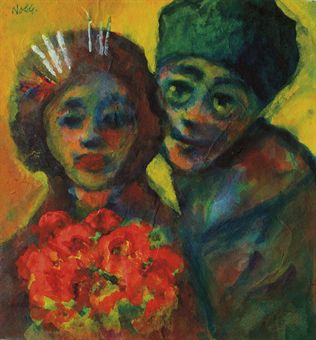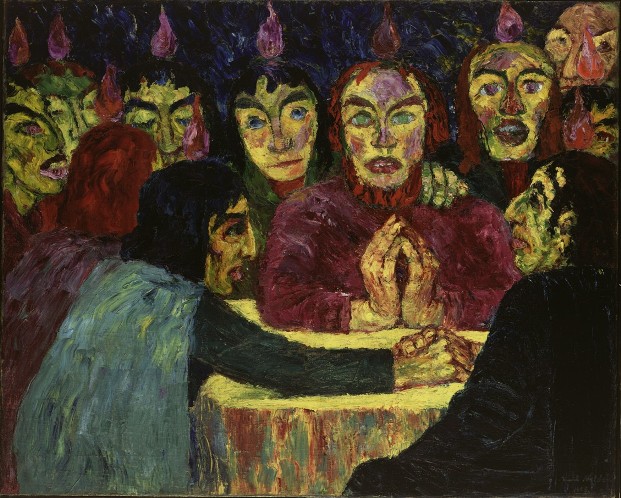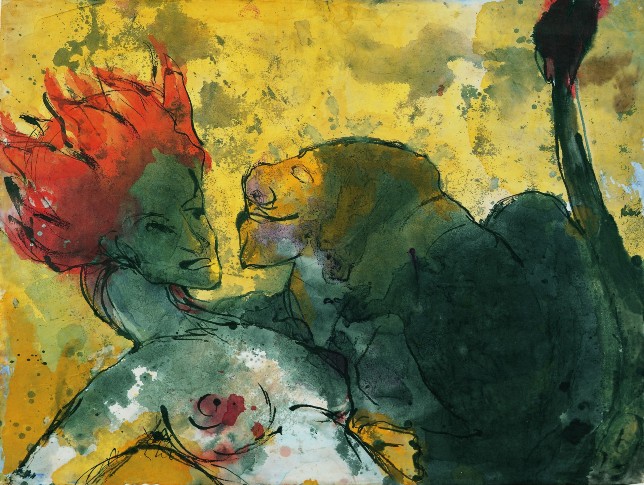It was a turning of the tables and an example of fate changing quickly and hinging on a bureaucratic judgement. Emil Nolde ( 1846-1956 ) was an anti-semite and German jingoist. By an ironic turn of history, he got what he deserved in 1937; Hitler declared his art as ”degenerate” confiscated 1,052 of his works, and in 1941 informed Nolde that he was altogether forbidden to paint. Oddly enough, his moral sensibilities were degenerate, but his paintings were not. Surprisingly, it seems the lack of precision and moderation, or more accurately, the surprising force of this tormented and violent art that were his undoing; the absence of neutered sterile combat replaced by a melting pot of disfigured romanticism and modern expressionism feeding off each other in a struggle for dominance.
Around 1910, Nolde began to gain a reputation for his work, ”Nolde’s art became much freer: he began to see that ‘dexterity is also an enemy’ and he allowed himself to create fantastic paintings ‘without any prototype or model, without any well defined idea … a vague idea of glow and colour was enough. The paintings took shape as I worked.’ The fantasies and the Biblical paintings he created at this time are generally considered his greatest works.”
By 1933, Nolde was offered the presidency of the State Academy of the Arts in Berlin.Despite some ominous signs to the contrary, Nolde had assumed that he would be immune from the Nazi campaign against Expressionism and other forms of modern art. In a certain sense the Nazi philosophy resembled his own, which continued to owe a debt to Nietzsche. He was stripped of his illusions by the events of 1937, when his work was included in the Degenerate Art Exhibition in Munich, with the centerpiece being his ”Life of Christ”.Worse was to follow. In 1941, the Reichskammer der Bildenden Kunste demanded that he send in his entire production for the past two years. Fifty four of the works he sent were confiscated, and he was forbidden to practise his vocation as an artist. Later Nolde went to Vienna to appeal personally to the Nazi gauleiter Baldur von Schirach – in vain.
Nolde’s best work were called his ”unpainted pictures”, for they were intended as studies for oils. He painted in watercolors during the war because he feared oils would betray him if Gestapo members should come to his house, in North Schleswig, and smell the paint. He had been a painter of landscapes and religious subjects and a pioneer expressionist, but during the war he turned mainly to vignettes of lonely old men and women and frightened huddling children.
Nolde achieved his luminous, haunting colors by allowing wet paint to flow over wet paper, and then later drawing the outlines. If the subjects are occasionally reminiscent of Edvard Munch’s fantasies, the bold command of water color was unprecedented. It appears likely that Nolde will be remembered more for his water colors than for his oils, of only because his incandescent landscapes, dreamlike visions, and strange figures were infiltrated by a tenderness and empathy; as if this forced withdrawal into himself displaced his own self absorption.
Emil Nolde added a special, mystical dimension to German Expressionism, and his career illustrates a number of the moral dilemmas which faced German Modernists of the first generation, since his instincts were nationalist and conservative, tribalistic and racist, even though his art was regarded as experimental. He seems indebted to his humble origins as the offspring of a Frisian peasant family, deeply steeped in Protestant fundamentalism mixed with an equal dose of paganism, and almost genetically distrustful of the ”Other” .












 COMMENTS
COMMENTS




I’ve seen it, but never had the slightest understanding of Expressionism until now. The tie in with Munch leaves no doubt. Now i consider the way Egon Schiele used similar media for a much different albeit expressionist (?) effect?
-mason
I couldn’t find better grade work he did illegally during the war. makes me think expressionism has a populist element somewhere.